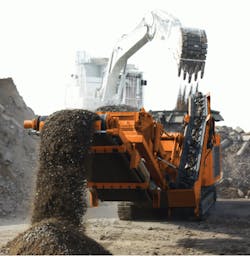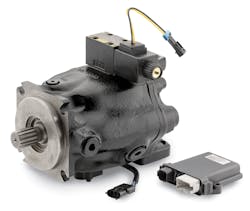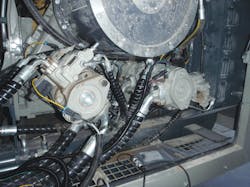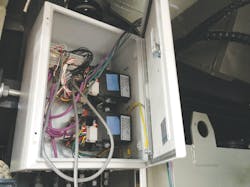New Mobile Impact Crusher Depends on Hydraulic Success
This file type includes high resolution graphics and schematics when applicapable.
Kormann Rockster Recycler GmbH specializes in the design and production of mobile crushers for the profitable processing of mined materials and recycling of concrete, asphalt, and demolition rubble. In response to customer requests, the company’s R1100D impact crusher — known for its robustness and high crushing ratio of any material — was selected to be redesigned for quieter and more fuel-efficient operation.
The new R1100DE machine uses an electric motor to drive the crusher’s main drum, while hydraulics provides all other mechanical power. The electric motor’s high starting torque makes it ideal for rotating the drum. Electrical power is provided by a generator driven at constant speed by the R1100DE’s diesel engine. Two pairs of tandem-mounted hydraulic pumps are also driven by the engine. And because the engine runs at constant speed, all pumps have variable displacement to deliver only that power required by the load.
Parallel Electric hybrid drive
With the goal of improving fuel efficiency, the Rockster R&D team worked in conjunction with a Finnish component manufacturer to develop a parallel hybrid solution. Unlike diesel engines, electric motors supply full torque from a standing start within milliseconds, can handle load changes efficiently, and enable a precise and steady crusher speed irrespective of the load demand. Permanent-magnet motors provide low-energy consumption, faster response, and higher power density than conventional motor-generator sets.
Peak loads are accommodated with batteries that temporarily store electrical energy. Any load peaks are cushioned by condensers, which buffer energy and reduce fuel consumption. The nearly wear-free electric motors reduce fuel consumption and maintenance costs. Ultimately, the R1100DE can save up to 16,000 liters of diesel per year.
To combat the frequent load peaks and severe environmental job conditions, Rockster made high demands on the material used. All electrical components are water cooled and comply with the IP65 standard. They are designed for use in mobile machines and suitably protected against dust, dirt, and water. In addition, they are resistant to vibrations and wide temperature variations.
Hydraulics for power and versatility
The Rockster R1100DE is equipped with variable-displacement piston pumps for the machine hydraulics and supply only that pressure and flow required by the load. This not only saves fuel, but also produces a steadily high material-handling rate, even with the diesel engine operating at relatively low speed.
The new hydraulic design uses four Parker P1045 pumps mounted in tandem from two power takeoffs (PTOs). All four pumps are equipped with Parker sequence valves at the outlet, providing zero-flow capability. An electronic-control unit monitors pump pressure and automatically commands pump displacement to match that required by the load.
The functions of the four pumps are as follows:
• One pump operates the machine’s right track, plus one of the conveyors.
• The second pump operates the machine’s left track and another conveyor.
• The third pump operates a hydraulic-fan drive for cooling.
• The fourth pump provides flow to a vibrating unit that screens stones after they have been crushed.
Previous machine designs were powered by fixed-displacement pumps, necessitating the engine to run at full speed to operate the conveyors at high speed. The variable-displacement axial-piston pumps, on the other hand, allow the engine to run at a lower speed, which saves fuel and reduces noise.
This file type includes high resolution graphics and schematics when applicapable.
Precise Control
A primary reason for selecting the Parker P1 pumps was the ability to precisely control the machine’s track speed and direction electronically. The crusher is a large, heavy vehicle, which makes loading onto a trailer for transport a challenge. Consequently, precise control is to safely and quickly maneuver the machine up and down loading ramps.
As a result, using four identical pumps simplified electronic control, yet, the pumps’ variable-displacement capability supplies each function with only that flow and pressure required. This is accomplished by tuning the displacement of each pump its individual load. With the hydromechanical controls that had been used on the old design, the four pumps were not interchangeable.
Summing Up
Rockster engineers have been able to integrate fast and repeatable flow for the track drives, cooling fan, and conveyors. The specific benefits gained include:
• Real flow on demand using electronically controlled piston pumps.
• Reduced diesel engine speed for increased efficiency.
• No bypass losses compared to the previously used fixed-displacement pumps, plus higher efficiencies than standard axial-piston pumps with load-sense control.
• Tuning stability via software parameters.
• Multiple setting potential to fit system conditions.
Parker P1/PD Series pumps are available with displacements of 18, 28, 45, 60, 75, 100, and 140 cc/rev, and accommodate system pressure to 4,060 psi (280 bar) for open-circuit applications. The Series features a computer-optimized design that significantly reduces noise. In addition, the pump’s minimized size and weight, as well as an adapted compensator design, simplifies installation.
The Series also features high overall efficiency and a wide operating temperature range. Overcenter operation in energy-recovery circuits is also possible where the pump can be
driven as a motor to transfer energy from the circuit back to the prime mover.
The electronic control on the P1/PD Series pumps permits a fast response to full stroke and a high damping ratio. The Series owes its characteristics to the integrated displacement sensor and pressure sensor coupled to the high-speed electronic controller that can be mounted any place with a wiring harness connected to the pump valve. This permits mounting wherever convenient, either inside an enclosure or at least away from the elements. In addition, the direct acting one-stage control solenoid — integral to the pump — features greatly reduced leakage flow when compared to conventional load sense control configurations.
Matthieu Guilbert is business development manager at Parker Hannifin’s Hydraulic Pump Div., Marysville, Ohio. For more information, visit www.phpump.com.
About the Author
Matthieu Guilbert
Parker Hannifin Corp.

Leaders relevant to this article:





